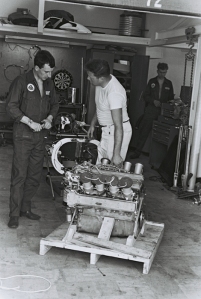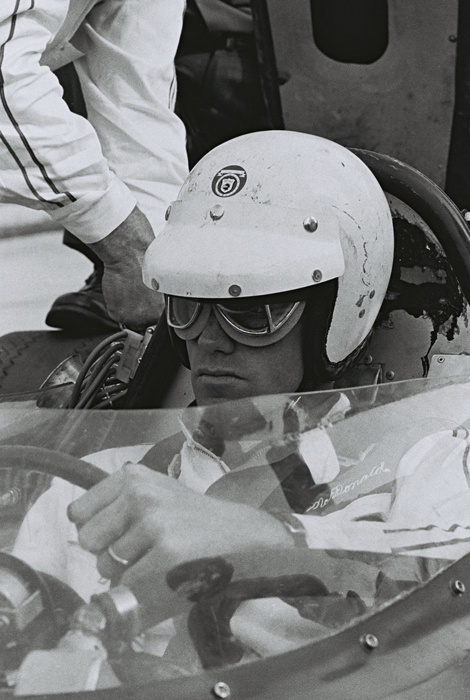Jim Clark and the 1964 Month of May
From the Silverstone International Trophy, Jim Clark, Dan Gurney and Colin Chapman flew straight to Indianapolis for testing of the new quad-cam Ford-engined Lotus 43s. In the photo album below we follow Jim’s progress through the month of May – back to Europe for the Monaco GP on May 10; to the US again for Indy qualifying on May 16; to Mallory Park and then Crystal Palace for May Bank Holiday racing; to Zandvoort for the Dutch GP on May 24; and then back to Indy for the 500 on May 30 (Memorial Day – a Thursday in 1964). That’s three big races in one month – with F2 and sports car meetings and lots of testing in addition. Images: LAT Photographic and The Henry Ford

Upon arrival at Indy on the Monday after Silverstone, Jim was annoyed to find that his car wasn’t ready. He thus sat out the first day of testing, listening-in to Dan Gurney’s reports. In the foreground, Colin Chapman applies some tank tape to the 43’s bodywork joins. Note that Dan here is running Jim’s aeroscreen

Still in casual trousers but now wearing the top half of his Dunlop overalls, Jim chats to Jack Brabham during that first day of Indy testing. Jack has just won the International Trophy at Silverstone and is running his own Offy-powered car at the Speedway. Note the asymmetric suspension and the fuel tank on the left side only

Much of the discussion at the test is whether Lotus should run Firestones or Dunlops. The British tyres are quicker but show early signs of chunking. Dunlop’s Dick Jeffries confirms that new batches will be made for the race and so Lotus, after much deliberation – and after asking the Firestone personnel to make a special trip to Indy for meetings! – decide to race Dunlops

It’s now the Tuesday of the Indy tests and Jim watches as Dan lowers himself into the blue-and-white Lotus 43-Ford, windscreen now converted to “Dan-spec”. Colin, clipboard in hand, stands left and on the right, holding a pyrometer, is Dunlop’s Vic Barlow

Jim finally gets to run and is immediately up to speed, matching Parnelli Jones’ 155 mph laps with apparent ease. He’s also wearing a new Bell helmet with the peak painted in dark blue rather than the regular Border Reivers white. He would race with this peak at Mallory, Crystal and Zandvoort (but not at Monaco, where he raced peakless) before reverting to a white peak for the Indy 500 on May 30

Aside from Dan and the roadsters of AJ Foyt and Parnelli Jones, major opposition at Indy would also come from the very talented Bobby Marshman. Driving one of the 1963 Lotus 29s updated with the four-cam Ford, Marshman, with Chapman’s blessing, did much of the four-cam testing and proved to be very quick at Indy throughout the month of May

Following the indecent speed of the Lotus-Fords in 1963, something of a war was waged at Indy in ’64 – front-engined versus rear, Firestone versus Dunlop, Offys versus Fords. This note sums up the home support for Parnelli and his Firestone-tyred, front-engined roadster

Although sponsored by Pure fuel and oils in 1963, Lotus switched to the American version of Esso in 1964. Here Colin Chapman stands by the Enco (as it was known) refuelling rig in Gasoline Alley

Colin Riley (left) chats to a Ford mechanic prior to an engine change. Note the little-used dart board in the Team Lotus garage…

Jim and Dan missed Friday practice at Monaco but in the case of the World Champion it made little difference. He qualified on the pole and was leading easily when his Monaco nemesis again intervened. First, the right rear roll-bar mounting broke on the Lotus 25. Jim called in quickly to have the complete bar removed – and still could have won but for an engine failure later in the race. His adaptation to the 25’s handling problem was remarkable

The right roll-bar mounting broke early in the Monaco GP, when Jim was pulling away from the pack with ease. Many observers believe the failure was caused on the first lap, when Jim brushed the straw bales at the fast exit of the chicane. I doubt this for two reasons: one, it was the right-hand-side that broke and, two, Jim states in the updated version of his autobiography that it was later proved back at the factory that the failure would have occurred regardless of whether he’d skimmed a wall or not. The design was subsequently modified

Jim, Colin and Dan flew straight back to the States after Monaco – another 4:30am wake-up call on the Monday after the race! – for Indy qualifying. Jim took the pole with a record four-lap average of 156.406 mph, then flew straight back to England to race the Ian Walker Lotus 30 at Mallory Park. A police escort helped him up the M1 motorway in the Bank Holiday traffic; he duly won the race (the only win for the 30); and then he drove back to Balfour Place with Sally in his white Radbourne Elan

Jim had won two-out-of-two so far with the F2 Ron Harris Lotus 32-Cosworth but at Crystal Palace on May 18 he ran into engine problems. The glory on this occasion went to the young Austrian, Jochen Rindt, although both David Hobbs (MRP Merlyn) and Graham Hill (John Coombs Cooper) were also very quick. Here Jim glides the 32 through the shadow and light of London’s own circuit

Jim made up for that disappointment by again having a ball with the Ford Lotus Cortina. He won his class at Crystal and is shown here in characteristic, early-1964 understeer pose

Jim drove his first Grand Prix at Zandvoort in 1960 – and was quick from the start. He raced the shark-nosed Ferraris hard there in 1961; he should have won there in 1962, when he debuted the new Lotus 25; and he won easily in Holland in 1963. In 1964 the pattern continued: Jim won the race at a canter. Note the tan Jim Clark driving gloves, that dark blue peak and the masking tape to protect him from flying stones

Dick Scammell checks the rear of Jim’s Lotus 25 on the Zandvoort grid while Colin gets the low-down. Behind, Bruce McLaren settles into the works Cooper while John Surtees, with Maruo Forghieri to his left, adjusts his helmet

Detail of the masking tape used by Jim at Zandvoort in 1964. He would use similar taping at Indy six days later

A study in concentration – on this occasion taken by Gary Bramstein, a US serviceman who in 1964 attended several European F1 races and is a massive Jim Clark fan

Special interior of the Radbourne Elan Jim used in 1964. Note additional switches on centre console and plush steering wheel boss

Jim had already made three separate trips to Indy before he finally returned for the race proper on Thursday, May 30, 1964. Exhausted by then thanks to the constant attention, the waiting around and the endless travel, Jim, like everyone, nonetheless became a part of it all when the marching bands struck up their tunes

With the gentlemen having started their engines, Jim, now with white peak, sets off for the pace laps. Eventual winner, AJ Foyt, is on the left and Bobby Marshman, who qualified second is behind. It was a capacity crowd

Dave MacDonald, the very talented American whom Jim knew well from the sports car series in the previous winter, qualified 14th in Mickey Thompson’s unwieldy, wide Ford rear-engined car, the Allstate Special. Its bodywork was much-altered by race day, featuring trim tabs and scoops front to rear. A glass-fibre-encased 45 gal fuel tank, containing nitro and other exotics, sat on the left of the driver

Indy veteran, Eddie Sachs, drove this Ford rear-engined Hallibrand special sponsored by Red Ball, the company that would ride to victory with Graham Hill in 1966

After gaining places right at the start, the brilliant Dave MacDonald was killed at Turn 4 on the lap when he spun into the angled extension of the inner pit retaining wall. The car exploded into flames and bounced into the path of oncoming cars

Eddie Sachs, who first raced at The Speedway in 1953, died when he tried to squeeze between MacDonald’s burning car and the outer wall. He hit the Allstate Special broadside. Both Johnny Rutherford and Jack Brabham drove through the inferno – and both had the perspicacity to accelerate onwards, using the slipstream of their cars to extinguish the flames

After a 90 minute delay, during which time he just sat by his car, back against a front wheel, Jim Clark again took the lead of the Indy 500. He was soon under tremendous pressure from Marshman, however – as seen here. It was Bobby’s consistently low line that settled the issue: he grounded-out the engine, causing an oil leak

As at Monaco, Jim then looked set for victory…only to run into trouble of a different kind: those Dunlops began to vibrate and then to chunk – and the rear suspension broke as a result. After a nasty moment on the home straight, Jim slid the 34 to a halt on the Turn 1 infield

A traumatic day ends with a walk back to Gasoline Alley. Jim peels off his gloves while doing his best to accommodate well-wishers

Jim’s 34 after its rear suspension failure. Note chunking on the left-rear tread. Thus ended Jim’s Month of May (50 years ago). It was violent and in many ways it was disappointing. There was no time to stop or to think, however, for he was a professional racing driver. The next race beckoned: the Belgian Grand Prix at Spa on the ultra-fast circuit that he’d disliked since 1958

























